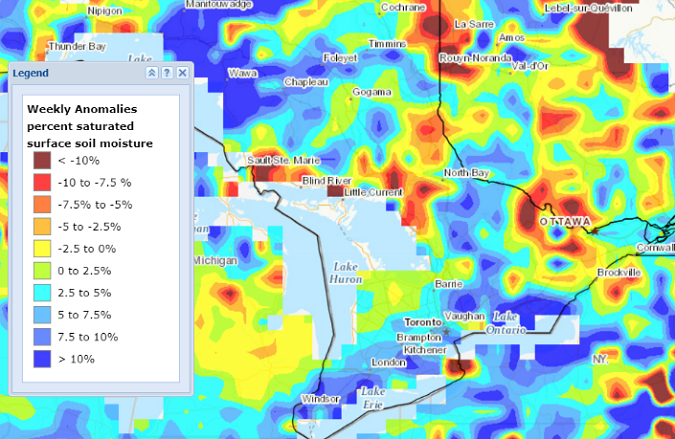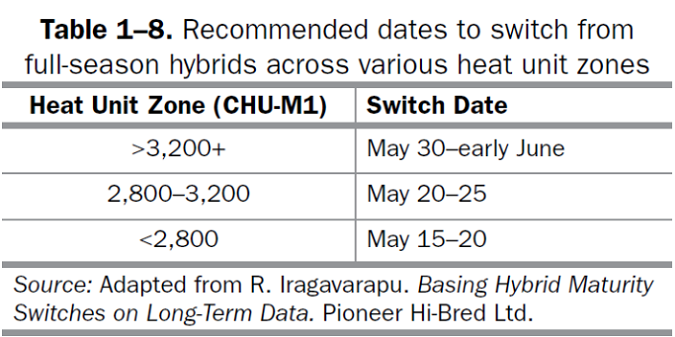Weather patterns have been variable, leading to regional differences in progress on planting and crop growth. Soils continue to remain unfit for field operations in large parts of the province, especially in much of the southwest and parts of eastern Ontario (figure 1). A few pockets have had windows of opportunity to catch up on cultivation, fertilizer spreading, and planting.

Figure 1. Soil moisture difference from normal, week of May 13th. AAFC Satellite Soil Moisture.
In every part of the province, some have felt pressured to “mud it in” and work in borderline to unfit conditions. The weather for the rest of the season will determine the short-term consequences; a crop in compacted soil will need timely rains to avoid potentially significant stress. Longer-term, subsoil compaction impact could be visible in crops for years to come.
Coping with the pressure and stress can be difficult when so much of what we depend on is out of our control. If you are being kept out of the field due to weather conditions, take the time to review your crop plan and prepare to adjust as conditions evolve. The crop plan acts as a reminder to stay the course where appropriate, and to develop a Plan B that can be used if certain conditions are met. Having confidence in a plan offers reassurance. When you can, support your neighbours and others in the industry with empathy, and do not forget to check in with others and yourself. Stop the spiral of negativity by bringing something positive to every interaction and reaching out when necessary. The Ontario Mental Health Help Line is 1-866-531-2600, or you can dial 211 to be connected to mental health support in your community.
Corn
Planting progress has mostly mirrored the weather radar and the soil map. Lighter-textured ground and areas that have been afforded a few days of favorable weather are between 50-80% planted, such as parts of Grey, Bruce, and Huron counties as well as some of eastern Ontario. Areas that have experienced consistent wet weather or have heavy soils remain almost completely unplanted. The provincial average is around 15%.
Growers across the province are starting to switch hybrids to lower maturities. The dates shown in table 1-8 of the Agronomy Guide for Field Crops indicate when it has historically been more profitable to plant lower-maturity hybrids than to run the risk of the crop not achieving full maturity before the average first frost see (Table 1.). This decision will depend in part on target moisture at harvest, the drying capacity of an operation, and drying costs. Switching hybrids is about season length and flowering date. Hybrid differences must be 200 Crop Heat Units (CHUs) or more to make a real difference in the field. Yield expectations also must be managed.

While there will be seed available for those switching hybrids from higher heat unit zones, there is some concern that lower heat unit zones will have limited options for non-neonicotinoid-treated seed in lower maturity groups. See ‘
Switching Hybrids and Class 12 Pesticides’ on fieldcropnews.com for more details and for alternative options.
Corn is particularly sensitive to being “mudded in”. If possible, consider planting soybeans in tougher conditions first to give corn fields a bit more time to get fit. Also, pay attention to hay crop maturity, and consider cutting before you finish planting corn; for every day of delay, forages lose quality faster than corn loses yield potential.
Soybeans
Some who can, have started planting soybeans. With the past winter in the rear-view mirror, those who have intentions for winter wheat are planting earlier-maturing soybeans to ensure a suitable planting window for winter wheat and improve the chances of winter survival. Under the tough conditions of this spring, soybean populations should be increased unless the weather really turns around and row width should be narrowed to get early interception of sunlight by the later canopy. Overall, soybean planting progress has been minimal to date.
Cereals
Though many of the winter wheat fields that were kept are looking better, it continues to be a management challenge full of stress and difficult decisions. Nitrogen has been applied to most fields by now, though conditions remained so unfit that some growers chose to apply by helicopter. Sulfur has also been applied to many fields. Soil-supplied sulfur comes from organic matter mineralization, so it is tied to soil organic matter levels. Cold spring conditions slow down mineralization and sulfur release. Sulfur deficiency can resemble nitrogen deficiency, so proper scouting is important.
Winter wheat stage is highly variable both within and between fields. In southwestern Ontario, the most advanced fields are at flag leaf while others are just barely emerging. This presents a challenge for timing inputs, especially for weed control and fungicide applications. If the flag leaf has emerged, the weed-control window has closed. In variable fields, T3 fungicide application to manage fusarium head blight should occur when most of the crop is at the right stage.
Spring cereals are emerging well where they were planted. The extended planting deadline from Agricorp has come and gone, but many of the intended spring cereal acres are still not planted. Planting beyond this date will be a function of feed and straw need. Delayed planting puts flowering into traditionally hot temperatures, which impacts yield potential.
Canola
The winter canola crop is flowering in southwestern Ontario and is being scouted to time fungicide application at 20 to 50% flowering. Spring canola is emerging well. Some acres intended for canola have not yet been planted. As a reminder, swede midge emerges at the end of May or beginning of June, so pheromone traps should be set soon.
Forages
Winterkill is a widespread issue this year and has some stressed about feed stocks. See
‘Check Alfalfa Stands this Spring and Make a Plan’ for more information on how to deal with the situation on fieldcropnews.com. Fields that were scouted early should be checked again because continued wet conditions may mean those plants have not survived. The planting season is still ahead of us, so producers have plenty of options for alternative forage crops, including:
red clover, cereals or
cereal/pea mixtures,
Italian ryegrass,
sorghum-sudangrass, millet, and silage corn.
Alternative forage crops can make great feed but require different management from traditional forages. Most are ready to harvest in 60 days or less, they don’t dry down well enough for hay, and they may require specific management to prevent animal health issues. See the articles linked in the list above for more information, as well as
‘Establishing Alternative Forages’ on fieldcropnews.com.
Source : Field Crop News